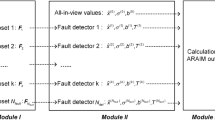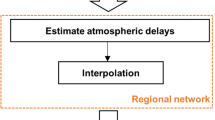Abstract
The allocation of integrity and continuity is crucial for the performance of integrity monitoring when multiple failure modes from multiple constellations have to be monitored. Using the four-state Markov model to link the integrity parameters, an optimal allocation algorithm for the slope-based receiver autonomous integrity monitoring is developed under the minimization criterion of protection level. The test based on a simulated dual constellation with various failure rates has shown that, when compared with other typical algorithms, the proposed algorithm can achieve a worldwide protection level decrement by at least 12.1% when the mean time between failures of each system is less than 103 h.


Similar content being viewed by others
Explore related subjects
Discover the latest articles, news and stories from top researchers in related subjects.References
Angus JE (2006) RAIM with multiple faults. Navigation 53(4):249–257
Blanch J, Walter T, Enge P (2010) RAIM with optimal integrity and continuity allocations under multiple failures. IEEE Trans Aerosp Electron Syst 46(3):1235–1247
Blanch J, Walter T, Enge P, Lee YC, Pervan B, Rippl M, Spletter A, Kropp V (2015) Baseline advanced RAIM user algorithm and possible improvements. IEEE Trans Aerosp Electron Syst 51(1):713–732
Braff R, Shively CA (2001) Derivation of ranging source integrity requirements for the local area augmentation system (LAAS). Navigation 47(4):279–288
Brown RG (1992) A baseline GPS RAIM scheme and a note on the equivalence of three RAIM methods. Navigation 39(3):301–306
Brown RG, Chin GY (1997) GPS RAIM: calculation of thresholds and protection radius using Chi square methods-a geometric approach. Global Positioning System, Institute of Navigation, vol V, pp 155–179
Datta-Barua S, Lee J, Pullen S, Luo M, Ene A, Qiu D, Zhang G, Enge P (2010) Ionospheric threat parameterization for local area global-positioning-system-based aircraft landing systems. J Aircr 47(4):1141–1151
Feng S, Ochieng W, Walsh D, Ioannides R (2006) A measurement domain receiver autonomous integrity monitoring algorithm. GPS Solut 10(2):85–96
Hwang P, Brown R (2006) RAIM FDE revisited: a new breakthrough in availability performance with NIORIAM (Novel Integrity-Optimized RAIM). Navigation 53(1):41–51
ICAO Navigation Systems Panel (NSP) (2006) International Standards and Recommended Practices, Aeronautical Telecommunications (Annex 10 to the Convention on International Civil Aviation), vol I (Radio Navigation Aids), 6th edn
Joerger M, Chan F, Pervan B (2014) Solution separation versus residual-based RAIM. Navigation 61(4):273–291
Lee YC (2008) Optimization of position domain relative RAIM. In: Proceedings of ION GNSS 2008, Institute of Navigation, Savannah, Georgia, USA, September 16–19, pp 1299–1314
Lee YC (2013) New advance RAIM with improved availability for detecting constellation-wide faults, using two independent constellations. Navigation 60(1):71–83
Li L, Jia C, Zhao L, Yang F, Li Z (2017) Integrity monitoring-based ambiguity validation for triple-carrier ambiguity resolution. GPS Solut 21(2):797–810
Oehler V, Trautenberg HL, Luongo F, Boyero JP, Lobert B (2004) User integrity risk calculation at the alarm limit without fixed allocations. In: Proceedings of ION GNSS 2004, Institute of Navigation, Long Beach, California, USA, September 21–24, pp 1645–1652
Pullen S, Enge P (2013) Using outage history to exclude high risk satellites from GBAS corrections. Navigation 60(1):41–51
Rausand M, Hoyland A (2004) System reliability theory: models, statistics and applications. Wiley, Mississauga
Rife JH (2013) The effect of uncertain covariance on a Chi square integrity monitor. Navigation 60(4):291–303
RTCA Special Committee-159 (1998) Minimum aviation system performance standards for the local area augmentation system (LAAS), RTCA/DO-245. RTCA Inc, Washington
Walter T, Enge P (1995) Weighted RAIM for precision approach. In: Proceedings of ION GPS-95, Institute of Navigation, Spring Palms, California, USA, September 12–15, pp 1995–2004
Acknowledgements
The authors would like to thank Professor Rene Jr. Landry from École de Technologie Superieure for the proofreading of this paper. This research was jointly funded by National Natural Science Foundation of China (Nos. 61304235, 61633008, 61273081, 61304234), the Fundamental Research Funds for Central Universities (No. HEUCF160416), and the Post-Doctoral Scientific Research Foundation, Heilongjiang Province (No. LBH-Q15033).
Author information
Authors and Affiliations
Corresponding author
Appendices
Appendix 1: Convergence of the proposed Markov model
The integrity and continuity should be allocated before the navigational operation. If the resulting integrity and continuity cannot be guaranteed to converge, the resulting integrity and continuity can be larger than the predefined integrity and continuity requirement with more integrity and continuity checks. Thus, for one failure mode, if the resulting integrity and continuity of the Markov model are guaranteed to converge, then
Based on the established Markov model (1), the increment of states P 2, P 1 and P 3 is
Rearranging (19), we have
With satisfying (21), and the constraint from P 0(k) + P 1(k) + P 2(k) + P 3(k) = 1,
If the initial state of the Markov model satisfies the constraints of (21) and (22), the required integrity and continuity have to be satisfied only at the initial epoch due to the decreasing trend of integrity risk and continuity risk.
Appendix 2: Derivation of differential terms
From (13), we have
Based on (9), let \(F\left( {P_{\text{fa}} ,T_{\text{fa}} } \right) = 1 - P_{\text{fa}} - \frac{1}{{\varGamma \left( {\text{dof}} \right)}}\int_{0}^{{T_{\text{fa}}^{2} }} {e^{ - t} t^{{{\text{dof}} - 1}} {\text{d}}t}\), and we can implicitly differentiate to get,
Similarly, based on (13),
With respect to (11), we have
Based on the definition of integrity risk and continuity risk from (4) and (5), the following can be derived from (1),
The differential terms in (14) and (15) can be obtained the equations from (23) to (27).
Appendix 3: Search range determination for the Lagrangian coefficients
For each failure mode, with allocating the total integrity risk requirement to the failure mode i, the maximum of P md can be obtained from the Markov model as
Thus, the minimum of K md is
in which erfinv is the Normal inverse error function. Setting up a maximum allowable position error (MAPE), e.g., the xAL, the upper bound of missed detection threshold can be determined as
Given the minimum and maximum of K md from (28) and (29), the searching range of λ can be obtained from (16).
As induced from (18), the searching range of μ can be achieved only if the variation of fault detection threshold T fa can be determined. Since K md can be derived first by the allocated integrity risk, the maximum probability of false-alert can be confirmed from allocating the total continuity risk to one failure mode,
Based on (9), the minimum of T fa can be achieved as
in which chi2inv is the Chi-square inverse cumulative distribution function.
Since xPL should be within the protection of the alarm limit xAL under the fault-free condition, the maximum of T fa can be obtained as
With the determined range of T fa from the above analysis, the searching range of μ can be derived from (18).
Rights and permissions
About this article
Cite this article
Li, L., Wang, H., Jia, C. et al. Integrity and continuity allocation for the RAIM with multiple constellations. GPS Solut 21, 1503–1513 (2017). https://doi.org/10.1007/s10291-017-0627-4
Received:
Accepted:
Published:
Issue Date:
DOI: https://doi.org/10.1007/s10291-017-0627-4




